There are few things better than Greek-style leg of lamb. It’s slow-roasted until tender with lemon, rosemary, and the most delicious potato wedges you’ve ever had. The perfect meal for Easter, or anytime you’re in the mood for a truly incredible, low-maintenance meal.
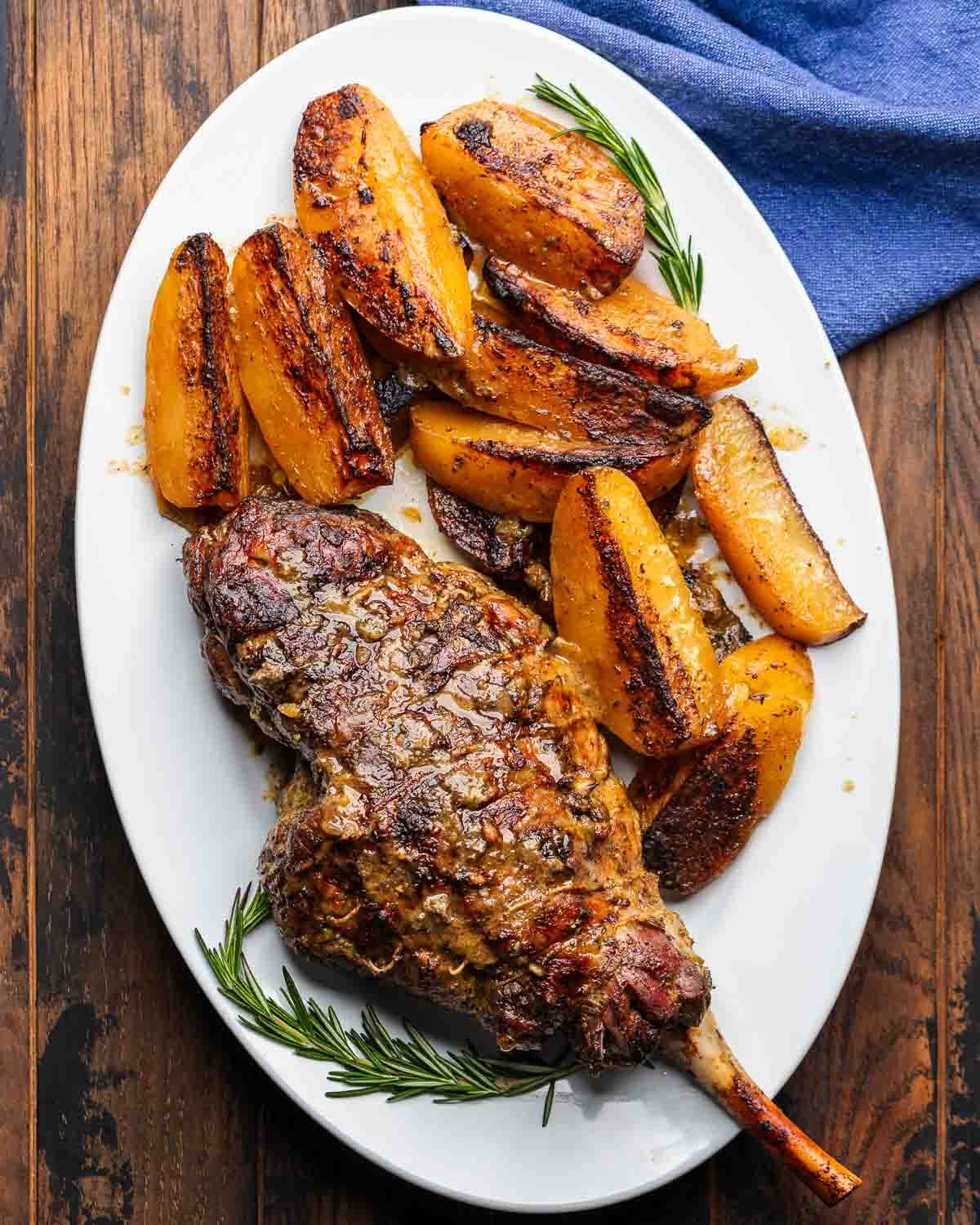
When it comes to lamb, there are two ways to prepare it: medium to medium-rare like this boneless leg of lamb, or long and slow-roasted until fall-apart-tender like this Greek leg of lamb with lemon and potatoes.
Because it’s slow-roasted it doesn’t require much maintenance making it ideal for holidays and gatherings.
Since the potatoes are roasted in the same pan, they soak up all the wonderful flavor of the lamb and the lemon-rosemary-oregano sauce.
The lamb and potatoes are served with a simple yet delicious ladolemono sauce that ties everything together and adds even more flavor.
This Greek-style leg of lamb and potatoes is great alongside roasted broccoli, green beans in tomato sauce, Greek salad, or baked asparagus with cheese and breadcrumbs.
Table of Contents
Recipe Ingredients
All ingredients for this recipe are shown in the pic below and special notes are made in this bulleted list to assist you.
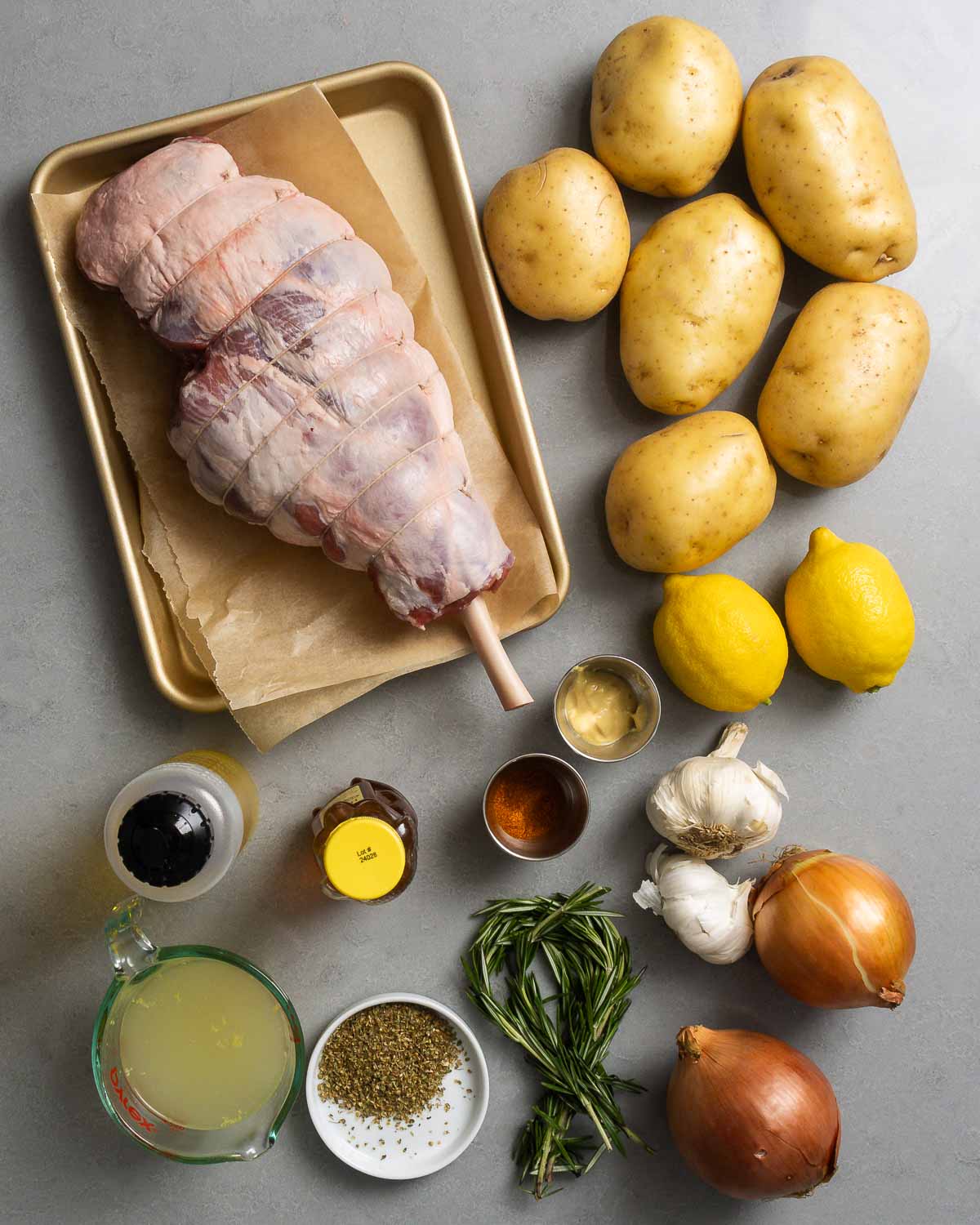
- Lamb. This recipe is for a 4 1/2 to 5 pound bone-in leg of lamb and includes salt and pepper to do a dry brine. Instructions to scale the brine for a different weight are below in the recipe notes. This recipe would be even better with a lamb shoulder, although it can be hard to find a full lamb shoulder here in the US.
- Potatoes. I recommend using Yukon golds and buying them individually so you can select the largest potatoes available. This will yield the long wedges you see in the photographs below.
- Chicken stock. If possible, use homemade chicken stock as you’ll have better control over sodium levels. You can also use a stock made from low-sodium chicken base.
- Herbs. Rosemary is used during the roasting process and dried Greek oregano is used for both the roasted potatoes and the finishing lemon sauce. If you can’t find Greek oregano, you can use regular dried oregano.
- Onions. These are optional and aren’t included in the print recipe below. If you like the addition, roughly chop 1-2 medium onions and toss with the potatoes.
See the recipe card for full information on ingredients and quantities.
How to make it
Each number corresponds to the numbered written steps below.
- If you bought from a butcher the leg was most likely trimmed, but if there is a very thick layer of fat you will want to trim off some of it. You do want fat on the leg and it should look similar to pic 1 below. Season the lamb with the dry brine of 2 tablespoons of Diamond Crystal Kosher salt and 1 teaspoon of black pepper. Place the lamb on a wire rack-lined baking sheet and refrigerate, uncovered, overnight. (Photo #1)
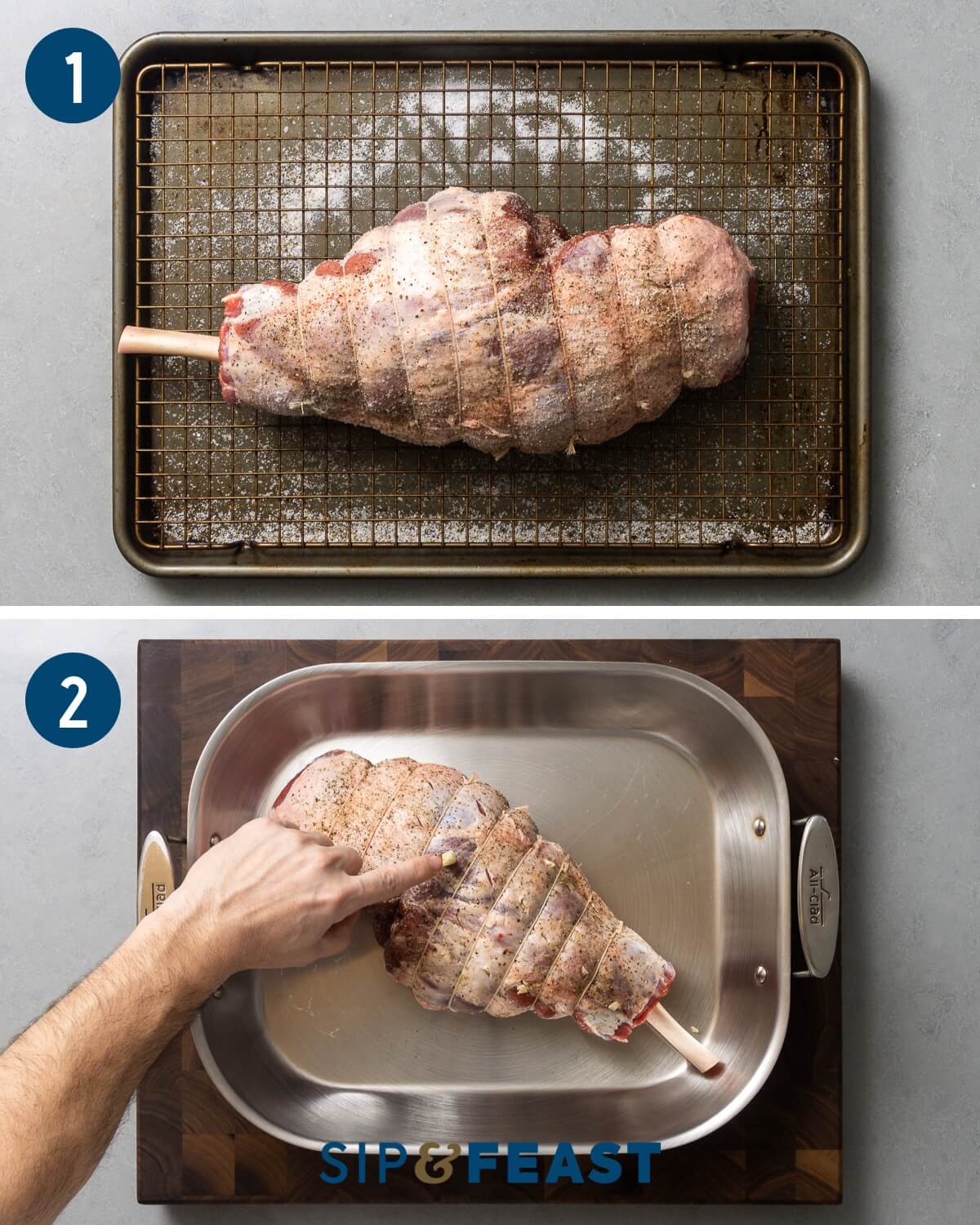
- 1 hour before roasting, remove the lamb from the fridge. Preheat the oven to 325f and set the rack to the middle level. Cut 5 garlic cloves into pointed slivers and make slits in the lamb, pressing each garlic sliver into the slits. (Photo #2)
- To a blender add 2 tablespoons of fresh rosemary leaves, 2 tablespoons of honey, 1 tablespoon of Dijon mustard, 1/3 cup of fresh lemon juice, 10 cloves of garlic, and 3/4 cup of olive oil and blend until smooth. Pour half the marinade over the lamb and use your hands to run it all over. Let the lamb sit and absorb the marinade for at least 30 minutes before roasting. (Photo #3)
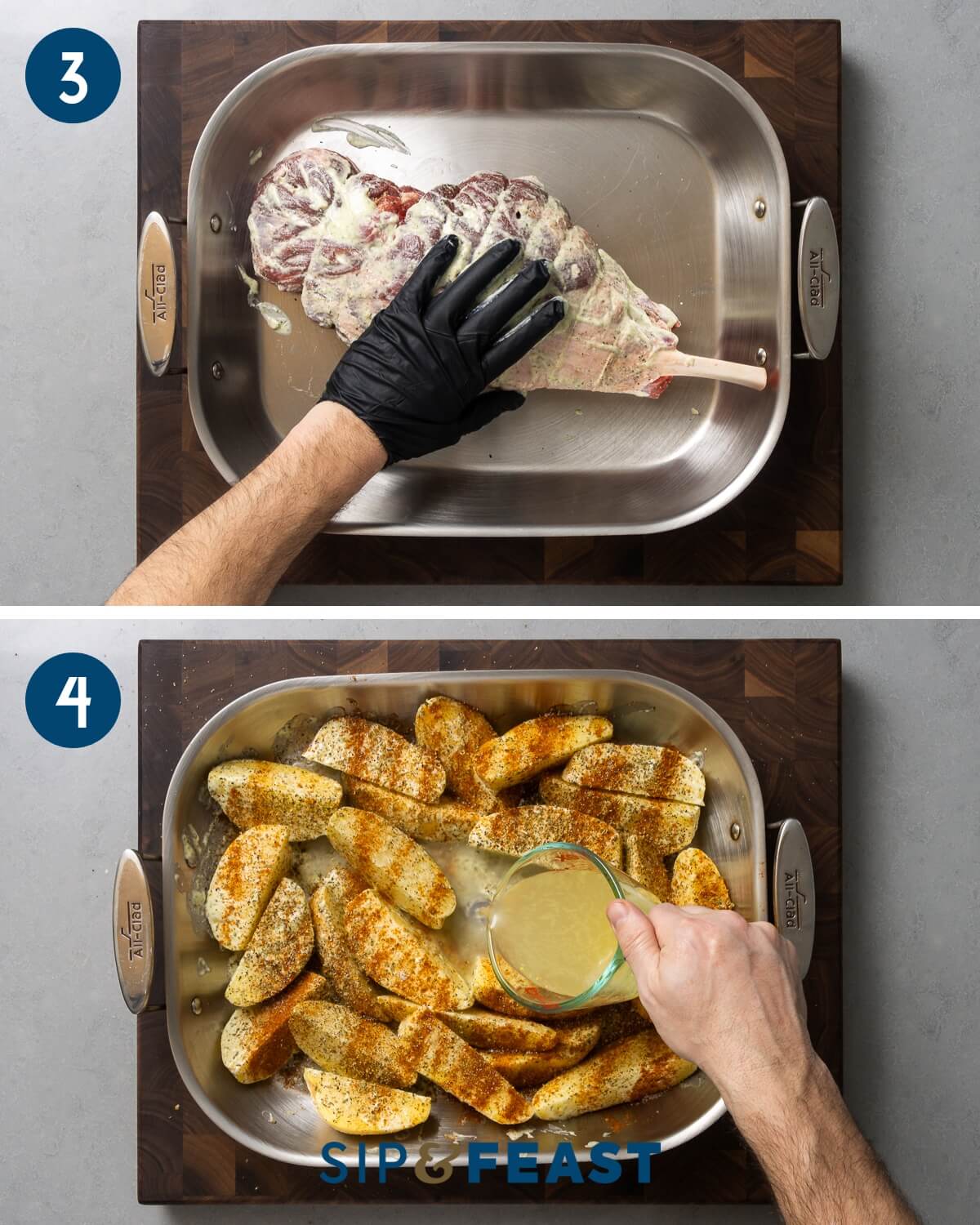
- Cut 3 1/2 pounds of large Yukon gold potatoes into large wedges and place them in a roasting pan large enough to accommodate them and the lamb. Pour the remaining marinade over the potatoes and mix well, then add 1/2 cup of low-sodium chicken stock to the pan. Season the potatoes with salt and pepper, 1 teaspoon of paprika, and 1 tablespoon of dried Greek oregano. (Photo #4)
- Place the lamb, fat side up, on top of the potatoes. You can insert a digital oven-safe thermometer into the thickest part of the lamb if you like, but it’s more important to cook the lamb to the proper texture instead of temp. More on that below. (Photo #5)
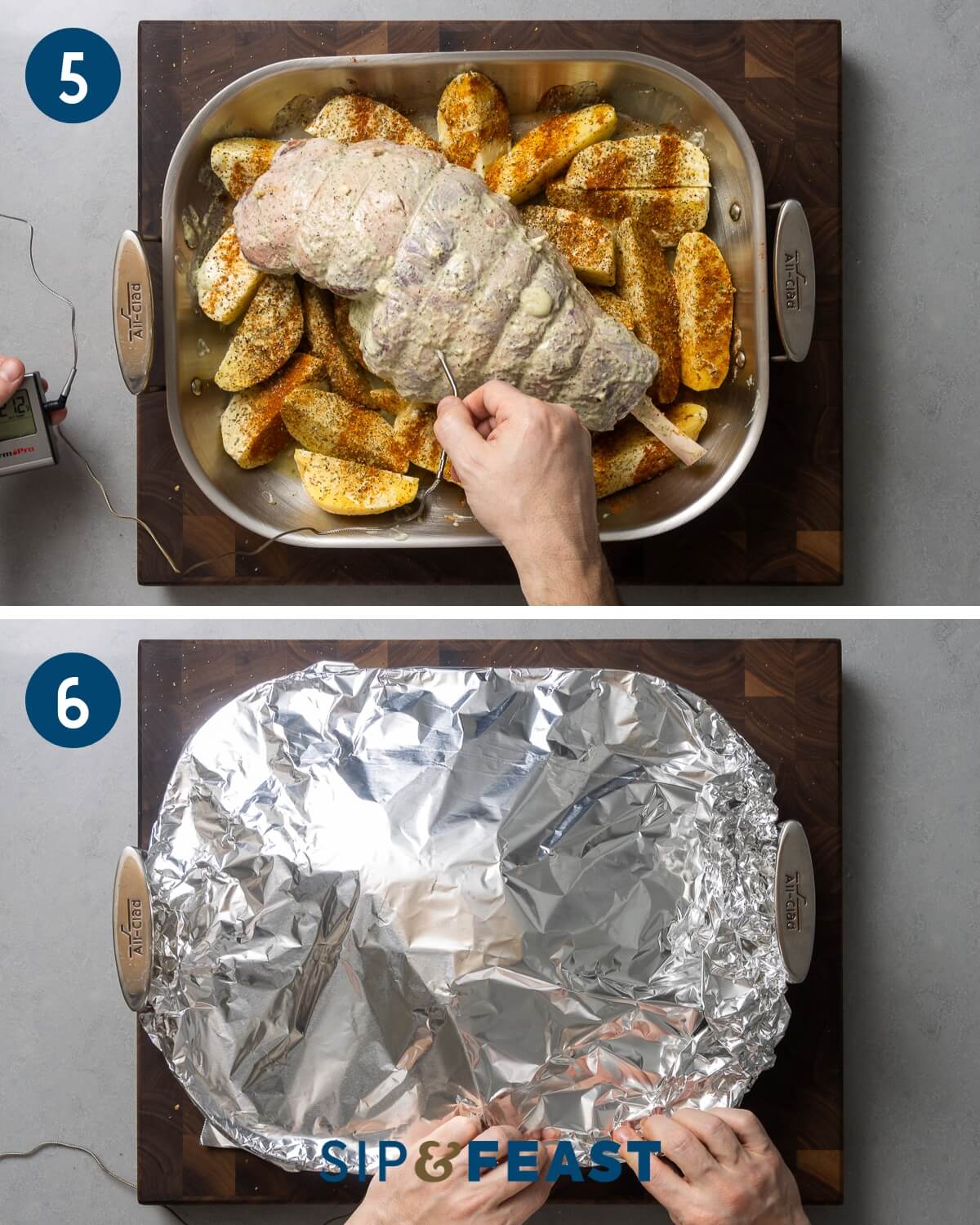
- Cover the pan tightly with foil and place in the oven to roast for 3-4 hours or until the meat easily pulls away from the bone and shreds. Test with a fork at the 3 hour mark and if it is still tough, cover and roast for another 1 hour. The temp of the lamb might get up to 180-190f during the stage. (Photo #6)
- Once the lamb is fork tender, turn up the heat in the oven to 450f and remove the foil. Allow the leg of lamb to roast for another 10-12 minutes or until lightly browned. (Photo #7)
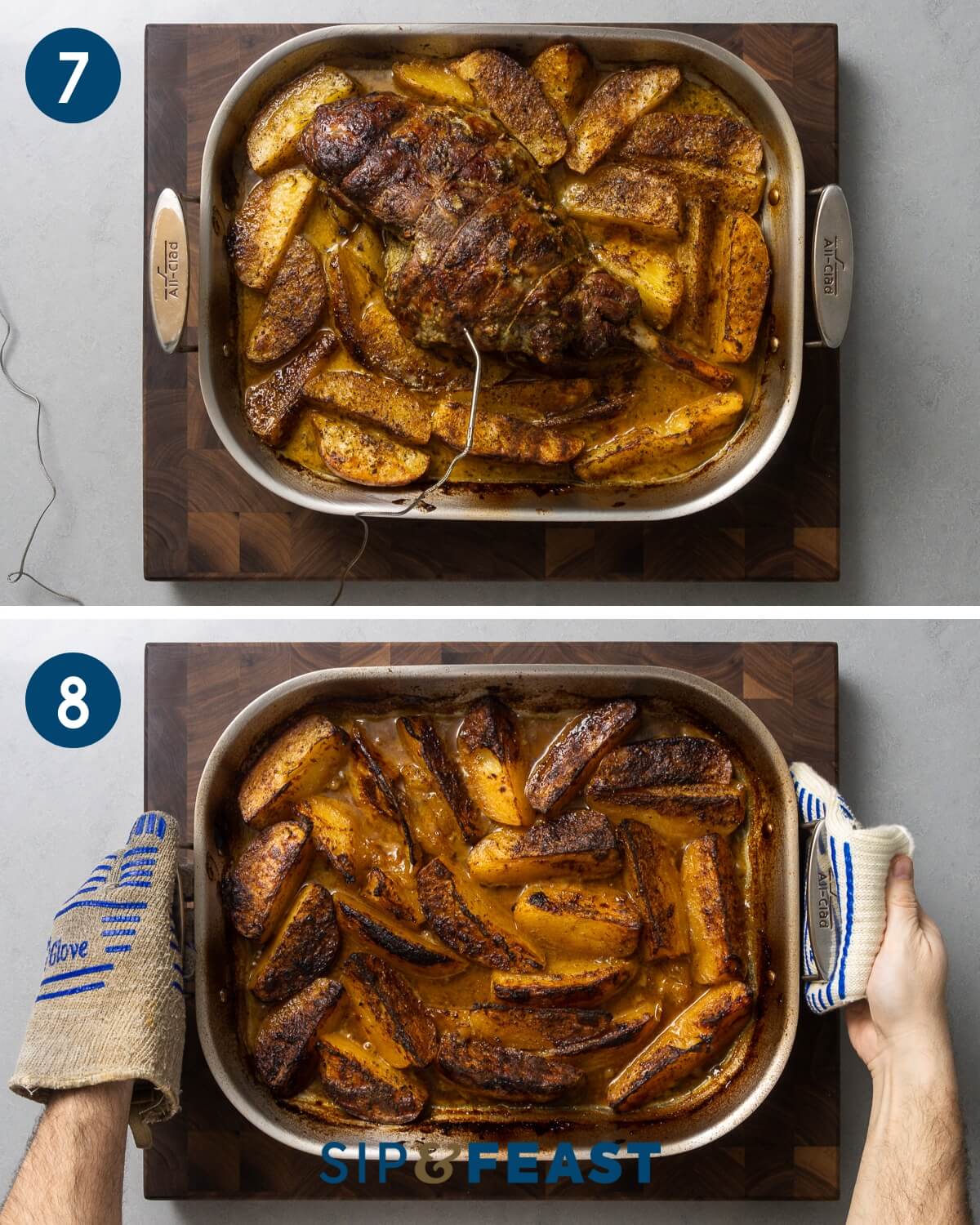
- Remove the lamb and place on a platter tented with foil. Place the potatoes back in the oven and continue to roast until most of the liquid has evaporated, about 20-30 minutes. While the potatoes roast, make the ladolemono sauce by combining 1/4 cup of lemon juice, 1 teaspoon of lemon zest, 2 teaspoons of Dijon mustard, 1 cup of extra virgin olive oil, 2 cloves of garlic (turned into a paste), 2 teaspoons of dried Greek oregano, 1 teaspoon of salt, and 1/2 teaspoon of black pepper. Whisk or blend the ingredients, taste test, and adjust salt as needed. (Photo #8)
- Place the potatoes on a platter with the lamb and use a ladle to degrease the remaining pan sauce. (Photo #9)
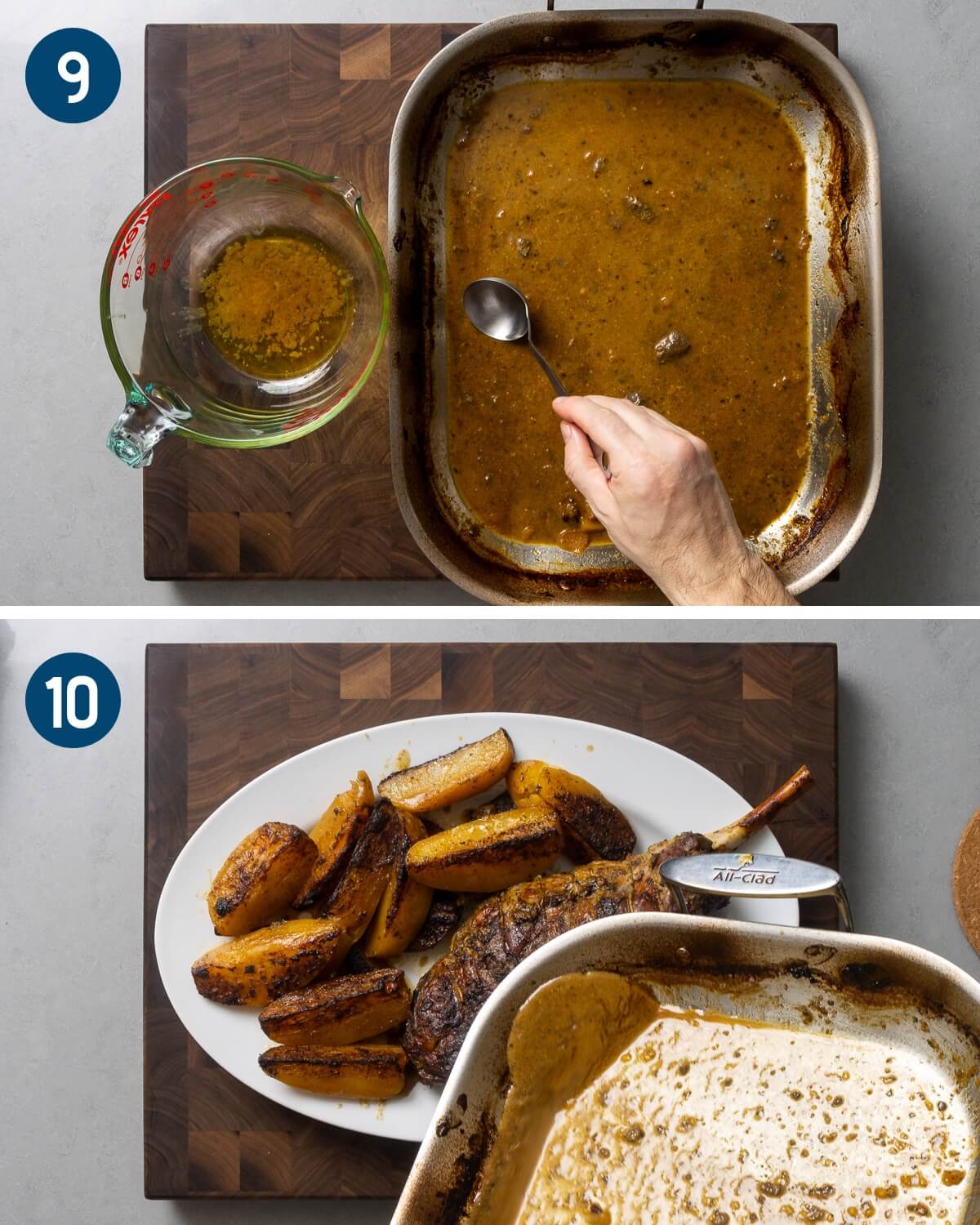
- Pour the pan sauce on top of the lamb and potatoes and serve with the Greek ladolemono sauce. The lamb can be sliced in it’s largest section and near the bones the meat can be pulled and shredded. Enjoy! (Photo #10)
Top tips
- Brining the lamb. I highly recommend dry brining the leg of lamb the night before making as it yields a more juicy roast. If you don’t have time for the dry brine, you can skip this step, season the lamb, and marinade.
- Cooking the lamb. A good rule of thumb is 3-4 hours (or 37-45 minutes per pound) tightly covered at 325f. Check it at the 3-hour mark and see if the meat pulls away from the bone without much resistance. Stick a fork into the meat and twist the fork. If the meat shreds it is done. If not, roast it covered for another 30-60 minutes. Cook the lamb for texture and not temp, though you can use a thermometer as shown above to help guide you. The final internal temp will be around 185-200f which is the optimal temp for slow-roasted lamb. Cooking to this stage allows for a shreddable consistency near the bone. If you prefer your lamb medium, roast it until the temperature hits 130-135f and allow it to rest until it reaches 140f, or for medium-rare, remove it from the oven at 125-130f.
- Fat side up. Placing the fat side of the lamb up to roast will yield superior results as it allows the fat to drip down and further flavor the lamb and potatoes.
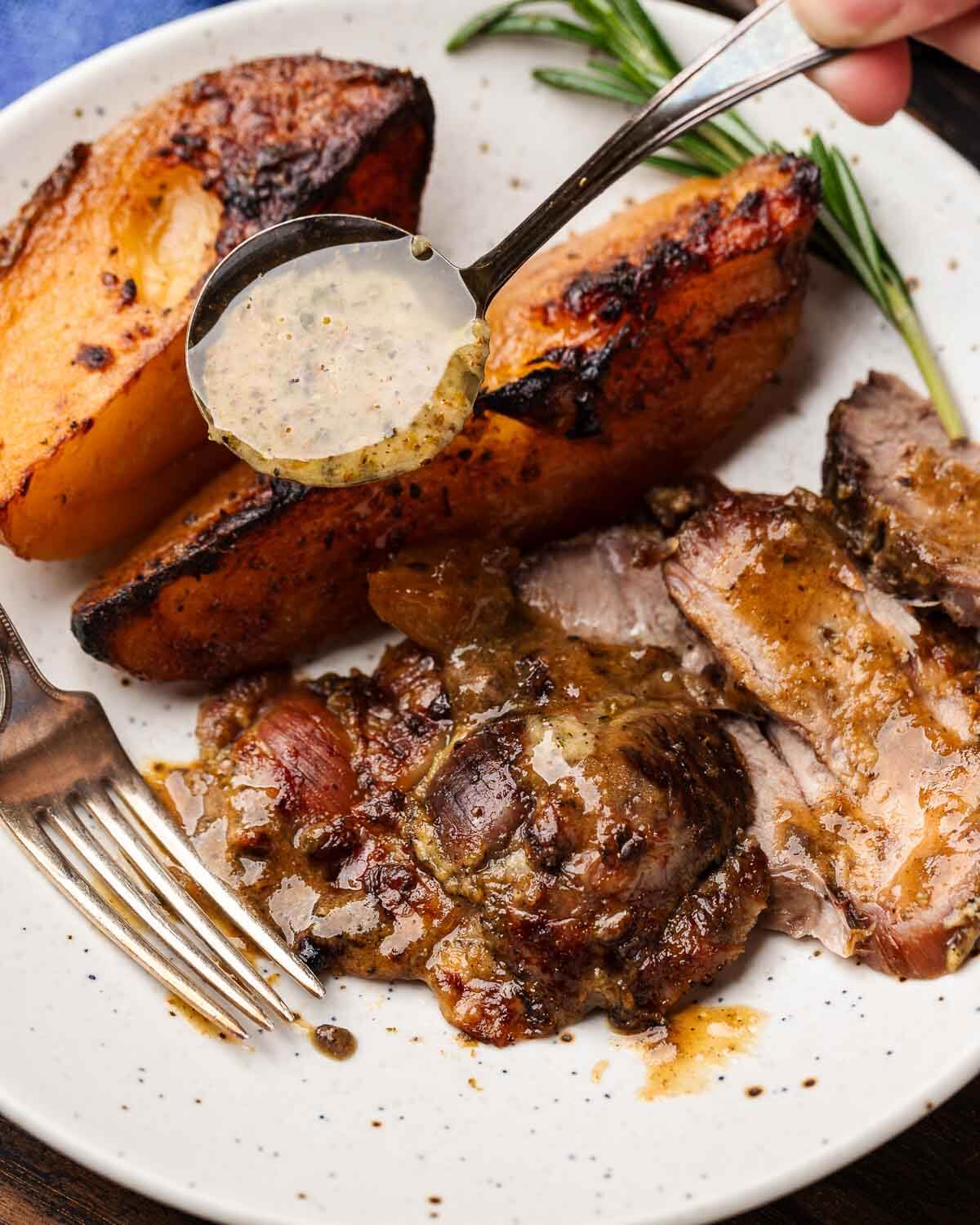
Roast recipes you’ll love
Whether you’re planning a holiday gathering or a special dinner at home, these are the tried and true roast recipes I love to make and know you will too.
- Prime rib au jus – foolproof method to make tender and juicy prime rib.
- Pot roast – tender braised chuck roast with potatoes and carrots.
- Italian stuffed pork loin – with garlic, pignoli, orange, and rosemary.
If you’ve enjoyed this Slow-Roasted Greek Leg of Lamb with Potatoes Recipe or any recipe on this site, give it a 5-star rating and tell us about it in the comments below.
We strive to satisfy a number of learning styles. If you are someone who prefers to learn by watching, you can find most of our recipes on YouTube and our Facebook Page.
Greek Slow-Roasted Leg of Lamb with Potatoes
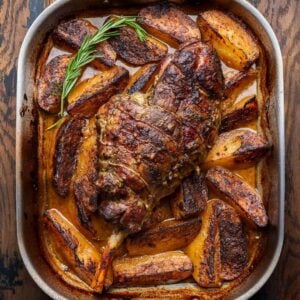
Ingredients
For the dry brine
- 1 4 1/2-5 pound leg of lamb trimmed of excess fat
- 2 tablespoons Diamond Crystal Kosher salt
- 1 teaspoon black pepper
Remaining ingredients
- 3 1/2 pounds Yukon Gold potatoes cut into large wedges
- 15 cloves garlic divided
- 2 tablespoons fresh Rosemary leaves
- 2 tablespoons honey
- 1 tablespoon Dijon mustard
- 1/3 cup fresh lemon juice
- 3/4 cup olive oil
- 1 tablespoon dried Greek oregano
- 1 teaspoon paprika
- 1/2 cup low-sodium chicken stock
For the ladolemono sauce
- 1/4 cup lemon juice
- 1 teaspoon lemon zest
- 2 teaspoons Dijon mustard
- 1 cup extra virgin olive oil
- 2 cloves garlic paste
- 2 teaspoons Greek dried oregano
- 1 teaspoon salt plus more to taste
- 1/2 teaspoon black pepper
Instructions
Salt (dry brine) overnight
- Season the lamb with salt and pepper and then place the lamb on a wire rack lined baking sheet and refrigerate, uncovered, overnight.
Marinate and roast
- Remove the roast from the fridge 1 hour before roasting. Preheat oven to 325f and set the rack to the middle level.
- Cut 5 garlic cloves into pointed slivers. Make slits in the lamb and press the garlic into those slits.
- Place the rosemary, honey, Dijon mustard, lemon juice, remaining garlic, and olive oil into a blender and blend until smooth. Pour half of the marinade over the lamb and rub it all over. Let the lamb absorb the marinade for at least 30 minutes before roasting.
- Place the potato wedges into a large roasting pan. Pour the remaining marinade all over the potatoes and mix well. Pour the chicken stock into the roasting pan. Season the potatoes with salt to taste and sprinkle the paprika and oregano all over.
- Place the lamb, fat side up, on top of the potatoes. Cover the pan tightly with foil and roast in the oven for 3 hours. Check the lamb with a fork. The meat should easily pull away from the bone and should be tender throughout. If not, cover and roast for another 30-60 minutes and check again.
- Once tender, turn the heat to 450f and remove the foil. Roast for another 10-12 minutes or until the roast is lightly browned. The final internal temp of the lamb might hit 190-200f. It is more important to cook the lamb until tender and shreddable than worrying about the exact internal temp!
- Remove the lamb to a platter and tent with foil. Continue to roast the potatoes until most of the liquid has evaporated (about 20-30 minutes).
- Place the potatoes onto the platter with the lamb. Degrease the remaining pan sauce and pour the sauce on top of the lamb and potatoes. Serve lamb with ladolemono sauce. Enjoy!
For the ladolemono sauce
- Blend or whisk the ingredients and season with salt to taste.
Notes
- Salting (dry brining) the lamb overnight is recommended.
- Brine at a 1% ratio of salt to total leg of lamb weight. A 5-pound leg of lamb weighs 2270 grams so it needs ~22 grams of salt which equals roughly 1 1/4 tablespoons of table salt. When using Kosher salt you will need to use more tablespoons because a tablespoon of Kosher salt weighs less than a tablespoon of table salt. See the table below:
- 1 Tablespoon of Table salt = ~19 grams
- 1 Tablespoon Morton Kosher salt = ~15 grams
- 1 Tablespoon Diamond Crystal Kosher salt = ~10 grams
- A note about doneness – This Greek-style lamb is supposed to be well done and shreddable. If you want medium-rare lamb, aim for 130°F or about 20 minutes per pound. Use an oven-safe thermometer for accuracy.
- Leftovers can be saved for up to 3 days in the fridge. To reheat, wrap the lamb in foil and cook in the oven at 350f until warm.
Nutrition
Nutrition information is automatically calculated, so should only be used as an approximation.







This was the most delicious lamb I have ever had. I thought I didn’t like lamb, and then I made this recipe because my family likes lamb and it blew my mind. Thank you for this recipe. Love the youtube videos.
We’re so happy you enjoyed, Danielle! Thanks for the comment!
Hi,
This looks great. Curious if you can use this method on a boneless leg of lamb. Thanks!
HI Catie, yes, you can definitely use a boneless leg of lamb here. You’ll need to tie it so it stays together. Hope you enjoy!
If I could give this 6 stars, I would 🙂 I did use lamb shoulder (3 lb roast ) as suggested in the video. That and the potatoes were to die for. Thank you for this great recipe!
We’re so happy you loved this one, Kate!
Absolutely incredible recipe!! I smoked the lamb leg on its own for ~2.5 hrs at 275F before raising the temp and proceeding in the roasting pan with the potatoes. Aside from that, followed the recipe exactly and it was fall-out-of-your-chair good. Thanks!!
Hello, I have a smaller cut of lamb, about 2 pounds. Do you have any suggestions on cooking time? Thanks!
Hi Zoe, please refer to the top tips section under “cooking the lamb” where Jim mentions 37-45 minutes per pound but that it really needs to be cooked until the meat is tender and shreds easily.
This Lamb recipe was fabulous. The taste was great. It roasted perfectly and the potatoes were delish!
Please explain what ladolemono means
Hi Irene, it’s a blend of olive oil, fresh lemon juice, garlic, and dried oregano. If you jump to the recipe card you can see the full recipe there.
Thanks for a great Easter dinner! This was my first lamb and it was terrific. It’s very satisfying to cook a meal and when the family digs in there’s a hush, with the only sound being various mmmms. The potatoes, the tender lamb, the lemony sauce – all so good and everyone loved it. Followed your recipe and it was spot on. Thanks again for your excellent work.
Love the recipe but it’s more like a 4:15 or even 4:45 due to the browning steps for the lamb and potato wedges. I trusted the time estimate in the writeup and now i’m going to be late to the potluck 😬
Made this lamb recipe for an Easter family gathering. Loved it, IMHO this Greek style lamb is so much better than the rare type. Loved the lemon flavor and garlic herbs. And those were some awesome potatoes!
Hi James. I made your boneless leg of lamb recipe tonight. It was very good but a bit chewy. I cooked it to 140 degrees. Do you find the slow roasting to produce a more tender meat. Would you recommend dry brining anyway you cook the lamb.
Hi Loretta, the boneless leg of lamb recipe and this recipe for slow roasted lamb are very different recipes. Personally, Jim prefers the slow roasted lamb in this recipe over the boneless, but both can be done well. In the end, it really comes down to personal preference – in fact if you go to the video on YouTube for the slow roasted lamb you’ll see a mix of comments from people saying lamb should only be cooked medium-rare, and others saying the slow-roasted until well done/fall apart tender is the only way to do it. Did you roast the lamb at 450 for the first 15 minutes and then drop the temp to 350? Skipping that step could have caused some of the fat to not render enough and create a chewier texture. Dry brining is always a good idea for meat.
Jim/Tara: one more question, because of my schedule I’ll have to do the dry brine two days before I cook the leg. Anything I should do differently?
Hi Werner. It will be even better after 2 days. Enjoy!
Hi Jim and Tara, please clarify my confusion re lamb and internal temp. This slow roasted leg cooks to a high internal temp, yet tender and falling apart. Your boneless leg cooks to a more typical 130 internal temp. I love this greek slow roast for something different but want to be certain I get nice results. (I am making for company and always do your recipes without doing a test run!) I see some long cooked lamb uses shoulder lamb roast although I don’t see that readily available nor does it look as appealing as your leg of lamb. Is it the covered long cook that keeps this meat juicy even when cooked to 180-ish? Thank you for your terrific recipe posts.
Hi Den. I promise you the leg will still be juicy at 190-200f internal. If you haven’t watched the YouTube video, please do. At the 9:00 mark I placed a thermometer into the leg after roasting and it registered 200f. I wanted to make the point that if you follow the recipe the lamb will shred. As far as a shoulder, if you can get one, it will be even better. Simply roast in the same manner and pull it out when tender. Depending on the size, it might take a bit longer. Hope this helps.
Jim: I plan to make this for Easter, I found a 5.45 lb semi boneless leg of lamb at my Meijer. It is not tied with string. Is it necessary to tie it with string? I appreciate your help,
Hi Werner, you don’t have to tie it. If it was completely boneless Jim recommends tying.
Will do, Thank you!
Do you serve the leg of lamb shredded like pulled pork or is it sliced? We always sliced it. I’m trying to visualize the guests picking at it from the platter. I’m assuming it’s already shredded like pulled pork and then served.
I love your presentations. You do a great job! All your recipes are devine!! Love the interaction between you and your cute son!
Hi Norina, you can do either. The lamb will be tender enough to shred but you can definitely slice it too. Thanks for the comment and so happy you’re enjoying the recipes!
Love your recipes. .. you explain everything so well and I’m no great shakes cook, trust me! But you have given me confidence to have a go and this leg of lamb will be my Easter go to! Thank you so much to you and your lovely family
At last I can venture to do a lamb roast like my other did. this is an amazing recipe and the notes and tips are the best. ill save the recipe for sure for Easter and the summer cottage.
Tips on a cold lamb luncheon in your next? *****
Love your recipes, they work every time! I always look forward to watching your UTube channel.